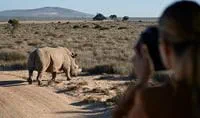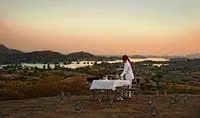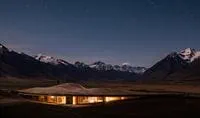How to Plan Your Safari Trip in Tune With the Wildlife
Safari trips are one of the most popular bucket list vacations, providing the chance to be surrounded by wildlife and see your favorite animals in their natural habitat - it can make you feel like you’ve just stepped into the world of The Lion King. A safari vacation can also be a great cross-generational experience for the whole family, with something for everyone to enjoy.
15 March 2022

Safari trips are one of the most popular bucket list vacations, providing the chance to be surrounded by wildlife and see your favorite animals in their natural habitat - it can make you feel like you’ve just stepped into the world of The Lion King. A safari vacation can also be a great cross-generational experience for the whole family, with something for everyone to enjoy.
From admiring the king of the jungle to spotting lesser-known but equally fascinating creatures like wildebeests and warthogs, an African safari is packed with memorable moments that will last a lifetime. But planning a successful safari trip entails understanding the daily patterns and behaviours of wild animals you would like to see, so that you can observe them in the least intrusive way.
To help you uncover which animals you are most likely to see on a safari trip, as well as understand their behaviour, we have analyzed available data to show you where and when you are likely to encounter them on your safari adventure.
The most popular safari animals in the US
According to the number of Google searches, lions are the most popular wild animal among Americans with an average search volume of 1.2 million per month. But where can you find them? Tanzania, Kenya and Botswana are places where you are most likely to find lions in their natural habitat. They are most active during dusk and dawn so if you are going on a daytime safari, you are most likely to catch them snoozing in the shade because they sleep up to 18 hours a day.
In joint second place for the most popular safari animals, are elephants and flamingos, reaching 450k average monthly searches each. While elephants sleep around 8 hours per day and are the most active during dusk and dawn, flamingos sleep only 2 hours a day and are the most active in the evening and early morning. If you’d like to see both of these animals, then you’ll stand the best chance of achieving that during an early morning safari trip in Tanzania.
Other popular wild animals include giraffes (368k average monthly searches), followed by cheetahs, and gorillas with over 240k searches a month each. However, on the other end of the popularity spectrum is the Cape Buffalo, which amounts to under 15k searches a month in the States. But these fascinating creatures sometimes sleep only an hour per day and are most active in the early morning and late evenings. They can be found in southern and eastern parts of Africa, such as Botswana and Kenya, normally near water sources.
-
![Masai Mara, Kenya]()
Masai Mara, Kenya -
![Serengeti, Tanzania]()
Serengeti, Tanzania -
![Swakopmund, Namibia]()
Swakopmund, Namibia
How about the other safari animals? Check out the full ranking of their patterns below:
| Animal | Search Popularity | Where to Go | Most Active | Hours Asleep |
|---|---|---|---|---|
| Lion | 1,220,000 | Tanzania, Kenya, Botswana | Dusk & dawn | 18 |
| Elephant | 450,000 | Tanzania, Botswana, Zimbabwe | Dusk & dawn | 8 |
| Flamingo | 450,000 | Tanzania, Kenya | Evening, night & early morning | 2 |
| Giraffe | 368,000 | Kenya, Zambia, Tanzania | Early morning & late afternoon | 5 |
| Cheetah | 246,000 | Tanzania, Kenya, Botswana, South Africa | Morning & evening | 12 |
| Gorilla | 246,000 | Rwanda, Uganda, the Democratic Republic of Congo | Daylight | 12 |
| Leopard | 201,000 | Zambia, South Africa, Kenya | Dusk & dawn, evening | 12 |
| Ostrich | 201,000 | Kenya, South Africa, Tanzania | Daylight | 11 |
| Hyena | 201,000 | Tanzania, Botswana, Namibia | Dusk & dawn | 10 |
| Crocodile | 201,000 | Kenya, Tanzania | Night | 10 |
| Zebra | 201,000 | Kenya, Botswana, Namibia, Tanzania | Daylight | 7 |
| Lemur | 165,000 | Madagascar | Daylight | 16 |
| Meerkat | 165,000 | Botswana, Namibia, South Africa | Daylight | 11 |
| Chimpanzee | 165,000 | Rwanda, Tanzania, Uganda | Daylight | 10 |
| Hippopotamus | 90,500 | Tanzania, South Africa, Zambia | Night | 16 |
| Jackal | 90,500 | Zambia, Zimbabwe | Night | 4 |
| Wildebeest | 60,500 | Tanzania, Kenya | Daylight & nighttime | 4 |
| White Rhino | 49,500 | South Africa, Namibia, Kenya | Early morning & late afternoon | 8 |
| Warthog | 49,500 | Kenya, South Africa, Zambia | Daylight | 7 |
| Oryx | 49,500 | Namibia, South Africa | Daylight | 5 |
| Black Rhino | 33,100 | South Africa, Botswana, Kenya | Morning & evening | 8 |
| African Penguin | 14,800 | Namibia, South Africa | Dusk & dawn | 8 |
| Cape Buffalo | 14,800 | Botswana, South Africa, Kenya | Early morning, evening & nighttime | 1 |
*Average sleeping hours are estimates found using the latest available data from various sources such as National Geographic, WWF and IUCN.
When is the best time of the day to go on a safari trip?
Taking into account the different schedules wild animals have, we asked Scott Dunn Africa travel expert Bjorn Behlert to share his tips for picking the best time of the day for an unforgettable safari.
Behlert says an early morning game drive is a great time to plan your safari trip as this is when most animals “are up and about as they start their day before the heat kicks in”. He says:
“This is an exciting, charged atmosphere, even for those who aren't morning people. You and your group huddle around the campfire with coffee and breakfast as your guides warm up the vehicles, then let the fresh air wake you as you drive out into the pink sunrise”
If you’re not an early bird, Behlert says afternoon safaris can also be “an incredibly fun event”. He recommends the following plan:
You head out around 4 PM and don’t get back until after dark, when you chat about all your sightings over candle lit dinner then wander off to bed. Typically you meet up with your group for late afternoon tea and cake, then head out into the park. In a private vehicle, you can have great fun bringing along a mix of drinks to enjoy on the drive. Animals come out as the sun starts to go down, making for great sightings and gorgeous champagne or sunset-red lit photos. Your guide will stop to set up a sundowner at an incredible viewpoint, like a clifftop overlooking a watering hole. Driving back to dinner in your camp in the dark, watching for nocturnal wildlife.
-
![Sabi Sands Game Reserve, South Africa]()
Sabi Sands Game Reserve, South Africa -
![Murchison Falls National Park, Uganda]()
Murchison Falls National Park, Uganda
Where to go to on a safari to see the most animals?
With so many great places to head to for your safari trip, it might be a tough choice to pick only one destination. Our Africa travel expert, Bjorn Behlert, reveals his best destinations:
“For seeing as many species as possible on your trip, my top two recommendations are South Africa and Kenya. In South Africa, the Greater Kruger area guarantees excellent viewing. In exceptional private parks like Sabi Sands, you’ll almost certainly see the Big 5 during your stay.
Kenya offers the classic safari experience you imagine - think Robert Redford in Out of Africa - with Maasai tribes, tented camps on wide open plains, and great game density in The Mara. If you time your trip with the wildebeest migration, you’ll see more wildlife than you can fathom. Seeing the Big 5 in Kenya requires more mobility than in South Africa, visiting different reserves and taking short flights around the country (flying in Africa an amazing experience in itself). Kenya’s expansive reserves give it a wilder, more natural feel”
-
![Okavango Delta, Botswana]()
Okavango Delta, Botswana -
![Sabi Sands Game Reserve, South Africa]()
Sabi Sands, South Africa -
![Serengeti, Tanzania]()
Serengeti, Tanzania
The unwritten rules of a safari trip
To make sure you make the most of the safari experience while being respectful of the animals, Behlert has some top tips:
- Ask lots of questions - the guides love it! They'd much rather talk and engage than drive in silence, and the more you ask the more you get out of it.
- Don't over-dress - wherever you're staying and however elegant or rugged your camp is, the safari look is all about cool, casual comfort. Shorts and a tee-shirt are all you need, and don’t wear anything too bright and flashy to make sure you blend in with the surroundings. To avoid pesky flies, stay away from wearing dark blues or black.
- Bring your own binoculars - the camps and guides can supply binoculars to pass around your group, but having a good pair around your neck to grab at a moment’s notice makes all the difference. I’d even go so far as to say they’re more important than a good camera!
- Put the camera away - as tempting as it is to chase the perfect shot, don't spend your whole safari looking through a lens. Take in the moments in real time. Embrace the absence of Wi-Fi to unplug – you can go online at home. Let Africa reset you, and tune into the nature around you.
- Be quiet - to make the most of your safari experience, keeping quiet and staying respectful of the wildlife on game drives is the best way!
With all these insights and expert advice, you’re now ready for your safari adventure. For more inspiration, take a look at our African safari vacations or get in touch to plan your trip.
+++
Main sources:
World Wildlife
Google Keyword Planner
National Geographic (various articles)
International Union for Conservation of Nature
Methodology:
Using publicly available data from the sources stated above, we gathered estimated figures about each animal’s popularity, sleeping patterns, time of the day when they are the most active as well as their conservation status.
This entry was posted in and tagged Safari.
Other blogs you may also be interested in...
Why Scott Dunn?
Unique to You

- We listen to your travel goals and craft unique trips that are personalized to you.
- We’re with you every step of your life’s travel journey, from honeymoons to family trips and beyond.
Seamless Service

- Global offices in the UK, US, and Singapore for 24/7 seamless service.
- We offer flexibility if your plans change so you can book with confidence and peace of mind.
Carefully Curated Collection

- We’ve curated an elevated collection of accommodation, experiences, and guides.
- Committed to fostering close global relationships to continue bringing you unique experiences.
Luxury in Every Sense

- We deliver a sense of luxury that matters most to you.
- Awarded Condé Nast Traveler’s Top Travel Specialists in the World 12 years in a row.











